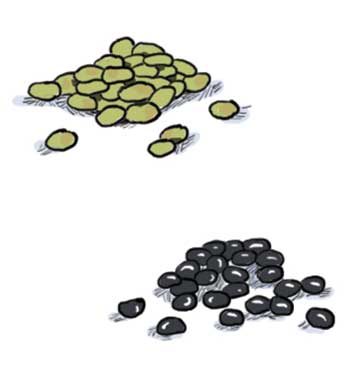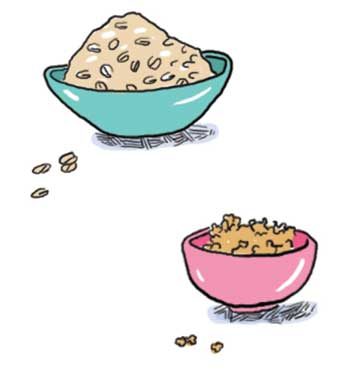
Goat’s milk
Why it’s great: Milk from animals that moo is a great source of the bone-building duo of calcium and vitamin D. But have you ever tried goat’s milk? A 2009 study published in the Journal of Food Composition and Analysis compared the nutritional makeup of milk from cows with milk from goats that had been raised under similar conditions. It found that the latter contained higher levels of bone-building calcium, phosphorus and magnesium. Both types of milk contain similar amounts of calories and fat; as with cow’s milk, look for low-fat versions.
How to enjoy it: Goat’s milk has a tang similar to that of soft goat’s cheese, so it works well in smoothies, quiches, puddings, hot chocolate and creamy soups. Or try it on hot or cold cereals.
Where to find it: Health food stores, some farmers’ markets, and the health food section of most large supermarkets.

Black beluga lentils
Why they’re great: Green lentils remain an inexpensive source of protein, fibre and folate. But lentils come in many shades that are worth exploring. Diminutive black beluga lentils (named after the glistening beluga caviar they resemble when cooked) have a striking jet-black skin and a slightly nutty, less earthy taste than green lentils. And unlike green lentils, black lentils possess anthocyanins, the same potent antioxidants found in dark berries such as blueberries and blackberries. Anthocyanins help to stymie free-radical cell damage, offering some protection from diseases such as cancer and heart disease. Like other legumes, black lentils are a nutrition dream, with impressive amounts of vitamins, minerals and protein-and a whopping nine grams of dietary fibre in a mere ¼ cup (60 mL) to keep you feeling full. Similar to green lentils, the black-hued ones contain only about 170 calories in a one-cup (250 mL) cooked serving. Black lentils take only 20 minutes to cook in a pot of simmering water until they are slightly tender. And unlike dried beans, lentils require no presoaking.
How to enjoy them: Because they hold their shape and chewy texture once cooked, black beluga lentils are a smart choice for salads, stews and soups. They pair particularly well with salmon, pork, mushrooms, roasted root vegetables, walnuts and mustard-infused vinaigrettes.
Where to find them: Health food stores and the bulk section of grocery stores.

Quinoa flakes
Why they’re great: If you already start your day with a bowl of oats, which are rich in cholesterol-lowering soluble fibre, pat yourself on the back. But for a tasty change of pace, try a bowl of porridge made with quinoa flakes. Similar to quick-cook oats, gluten-free quinoa flakes are made by passing whole quinoa grains through rollers to flatten them. This makes them faster cooking than regular quinoa. Billed as a super-food and a complete protein, quinoa has a laudable nutrition profile including a range of vitamins and minerals such as iron, phosphorus, folate and magnesium, and it’s high in fibre. A number of studies suggest that higher intakes of magnesium can be protective against developing type 2 diabetes.
How to enjoy them: Similar to quick-cook oats, quinoa flakes cook in boiling water in just a couple of minutes. Add about ? cup (75 mL) quinoa flakes to one cup (250 mL) simmering water and stir until creamy. Add spices, nuts and fruit for a delicious morning meal. Also use them when making fruit crisps, or try quinoa flakes as a coating for fish and chicken. Because quinoa flakes become mushy when cooked, use regular quinoa for salads, soups and side dishes.
Where to find them: Health food stores.

Broccoli sprouts
Why they’re great: Alfalfa sprouts are rich in bone-building vitamin K and are a great way to add low-calorie crunch to sandwiches and salads, but they’re not the only sprouts around. Crisp broccoli sprouts are very young broccoli plants that resemble alfalfa sprouts, but have more of a peppery bite similar to fresh radish. Compared to mature broccoli heads, sprouts contain up to 100 times more of the phytonutrient sulforaphane, which has been shown to have strong cancer-preventing effects. (Alfalfa sprouts don’t contain sulforaphane). It’s thought that this phytonutrient can elevate levels of the body’s protective enzymes. Munching on broccoli sprouts may also help protect your stomach from the bacteria responsible for many cases of ulcers, gastritis and stomach cancer, according to a 2009 study by researchers at the Johns Hopkins University School of Medicine.
How to enjoy them: Pile them raw atop your salads, stir-fries, soups, sandwiches or poached eggs. Or make a lively sauce for fish by blending broccoli sprouts with extra virgin olive oil, lemon juice, garlic and sea salt.
Where to find them: The vegetable section of most supermarkets.
Related:
• New twists on 10 great foods
• New takes on 6 great foods
• The 5 best foods you can eat
